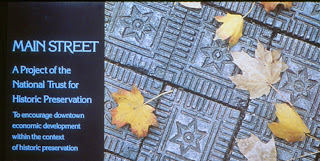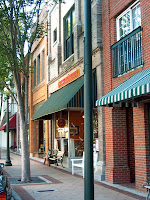With the establishment of Swiss Bear in 1979 and a local downtown effort in progress, under the leadership of Mayor Leander Morgan, City Planner David Rowland applied to the NC Department of Natural Resources and Community Development in 1980 for New Bern to be a participant in the state’s new Main Street Program. In 1981, New Bern, along with Shelby, Washington, Tarboro and Salisbury were chosen out of a field of nearly 200 cities vying for the honor. The NC Main Street staff would provide guidance and encouragement but the degree of success would depend on the leadership invested in the program by the people of New Bern. Intensive training and technical assistance was provided during 1981 and the NC Main Street Center was available for follow-up consultation for two years.
Based on the successful and comprehensive revitalization strategies developed in the National Trust for Historic Preservation’s three original pilot towns in the 1970’s, the Main Street program’s goal is to encourage economic development within the context of historic preservation.
The Main Street Program combines four elements to create a well-balanced program.*
- Organization: Building partnerships to create a consistent revitalization program and develop effective management and leadership downtown. Diverse groups - merchants, bankers, public officials, chamber of commerce and civic groups - must work together to improve downtown.
- Promotion: Re-establishing downtown as a compelling place for shoppers, investors, and visitors. This means not only improving sales but also rekindling community excitement and involvement. Promotion ranges from street festivals to retail merchandising, from community education to marketing and public relations.
- Design: Enhancing the visual quality of the downtown. Attention is given to the downtown environment elements – not just buildings and storefronts but also public improvements, rear entries, signs, landscaping, window displays and graphic materials.
- Economic Restructuring: Strengthening the existing economic assets of the business district while diversifying its economic base. Activities include conducting market analysis to understand the changing market place, adapting vacant buildings that have outlived their original purposes for use as entertainment or cultural facilities and sharpening the competitiveness of Main Street’s traditional merchants.
The initial step was the visit of a resource team of five consultants for a three day evaluation and meetings with local leaders and elected officials. The following is a summary of their final report presented to citizens as a framework for New Bern’s revitalization effort.
- David Rowland and Kay Williams (Swiss Bear’s newly hired executive director) should serve as co-project managers for New Bern’s Main Street Program.
- The local government should continue to support Swiss Bear financially for at least the next three years.
- The city government and Swiss Bear should establish goals and objectives and a year by-year schedule of improvements in the central business district.
- Swiss Bear should expand its activities in the areas of promotion, recruitment and retention of businesses, development of a revolving fund and a low interest loan-pool and facade improvements.
- Swiss Bear and the merchant's association should work together closely.
- The Chamber of Commerce should pursue a more aggressive tourism program in conjunction with the Main Street project.
- The off-street parking areas need to be improved with paving and landscaping.
- Street and traffic lights need to be improved.
- Facade and sign improvements must be implemented as soon as possible.
- The urban renewal area should be treated as a natural extension of downtown.
- The urban renewal area should be developed for housing rather than office or commercial use.
- The community needs to adopt a sophisticated development approach to fill vacant buildings and upper floors.
The City, County and the Swiss Bear board formally adopted the Main Street approach as its strategy for downtown’s revitalization effort and served as a pivotal role in the organization of the local Main Street Program. By emphasizing the Main Street theme of self-help, the program provided the framework and opportunity for the merchants, the city and county government and the business community, everyone who had a vested interest in downtown, to come together.
Like all plans/reports, the recommendations were meant to suggest appropriate and effective steps in developing a program of achievable goals and objectives. Decisions by the public and private sector over the long term on development and redevelopment decisions provided a unified sense of direction for downtown’s future. Thanks to the energy and leadership invested in the program by Swiss Bear, the City, County, Chamber of Commerce, other nonprofit organizations and the citizens of New Bern over the past 35+ years, New Bern’s downtown effort is widely recognized in the state and nation as an award-winning Main Street success story.
Strategies and projects will be related in future columns.
*The NC Main Street Program is under the Dept. of Commerce. www.nccommerce.com





